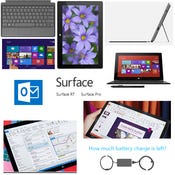Microsoft is having trouble selling the Surface tablets it


10 Ways Microsoft Could Improve Surface Tablets
10 Ways Microsoft Could Improve Surface Tablets (click image for larger view and for slideshow)
Nvidia CEO Jen-Hsun Huang said Thursday that his company is working with Microsoft on a new Surface RT tablet. Given that earlier reports have indicated Microsoft is also testing devices with Qualcomm's Snapdragon 800 chip, it's looking increasingly possible that the company will replace its underachieving Surface tablet with not one, but two new products.
Microsoft reported in July that its Surface RT and Surface Pro, which respectively debuted in November and February, had only $853 million in revenue combined. Apple, in contrast, needed only three days last November to sell three million iPads, and it sold 14.6 million in its most recent fiscal quarter.
Given these challenges, it might seem counterintuitive for Microsoft to expand a product line it's already struggling to sell. It might be better to shore up the existing lineup before burning through the extra R&D, factory and advertising money that additional models would entail.
[ Where does Microsoft's struggling tablet fit in? Read Why Schools Could Save Windows RT. ]
Then again, if the current tablets' respective market positions aren't working, a shake-up might be precisely what the Surface brand needs. Here are three reasons Microsoft should make three different Surface tablets.
1. Three tablets would provide an entry point and an upgrade path.
When Microsoft first priced its Surface tablets, it made a colossal miscalculation, assuming that it could simply follow Apple into the high-margin device business. If Microsoft had released a tablet three years ago, perhaps this plan would have worked. But Microsoft was late to the game and Apple has an entrenched user base in the premium market. Consequently, Microsoft needs to follow something more akin to the Android model: produce budget-friendly flagship products that increase adoption and funnel users toward the costlier, more profitable devices. Three Surface models would allow Microsoft to pursue this sort of strategy.
From a components standpoint, a 7-inch Surface RT tablet with a Qualcomm chip shouldn't cost much more to produce than the Nexus 7. If Google can afford to price the Nexus 7 at $199, then Microsoft can certainly aim for similar build quality at a similar price. The Snapdragon chip should provide LTE support, allowing Microsoft to produce an ultra-mobile tablet that better highlights the company's cloud-based assets, such as SkyDrive and Bing apps. Support for Office, including Outlook, meanwhile means the device could be useful not only for content consumption but also as a BYOD companion device.
If the price is right, Microsoft could significantly boost Windows RT adoption, which would in turn lead to increased developer investment in the Modern UI. More developer activity would send benefits rippling across the entire Windows 8 ecosystem.
A second Surface RT model could provide both a bigger, nicer screen and an upgrade path for those who like the smaller RT model but need a device that's more suitable for heavier Microsoft Office tasks. It's hard to know how much demand there is for this sort of device, given that some Atom-based Windows 8 tablets could soon cost as little as $300. Unlike Window RT models, Atom-fueled machines can run desktop apps.
Nevertheless, if Microsoft can boost adoption with a low-cost RT model, it could at least buy itself the flexibility to continue developing larger more, capable RT devices.
The Surface Pro, meanwhile, will eventually gain a Haswell chip, leaving it as a premium model with long battery life and the ability to run x86 apps.
Thanks to Microsoft's cloud investments, the devices should sync well together, which could encourage some users to own multiple Surface tablets, and to use them in tandem. 2. Multiple Surface RT models would help Windows RT survive OEM skepticism.
On Friday, Asustek announced that it has abandoned its plans for future Windows RT products. CEO Jerry Shen told The Wall Street Journal that the entire industry has perceived that Windows RT "has not been successful."
Indeed, aside from Dell, which is mired in a soap opera of its own, Microsoft is essentially the only major producer of Windows RT products.
By producing multiple Surface RT models, Microsoft can reassure its partners that Windows RT is worth supporting. If Microsoft chooses to release only one Surface RT model, the company could still face OEM challenges; a successful 8-inch Surface tablet, for example, might inspire OEMs merely to produce "me too" 8-inch tablets of their own, rather than to explore the OS's potential more thoroughly. But if Microsoft can succeed with a variety of RT options, it can inspire OEMs to approach the platform with enthusiasm and creativity.
3. Microsoft needs device fanfare to accompany Windows 8.1, and to coincide with enterprise hardware upgrades.
Microsoft has only opaquely acknowledged that new Surface models are coming, and it hasn't confirmed any release dates. Nonetheless, multiple models could help Microsoft increase Windows 8.1 fanfare in several ways.
If the company releases one of the models before the end of the year, the device would arrive in time not only for the holiday season, but also to cash in on user interest in Windows 8.1, which will be released later this fall. Surface devices released next year, meanwhile, could capitalize on enterprise hardware upgrades, which are expected to pick up as Windows XP's April 8, 2014 end-of-service date nears.
For business years, a refreshed Surface Pro could have an obvious appeal, especially if Microsoft prices the device no higher than the current Pro's discounted base price of $799. But with a variety of other Surface models, Microsoft would have more flexibility to target specific use cases and business verticals. A larger Windows RT tablet might be attractive to a mobile salesperson, for instance, whereas a 7-inch model that syncs perfectly with a Surface Pro could be a nice secondary device for a traveling executive.
If Microsoft follows this strategy, it will still have to find the right prices and features to make the various devices attractive both individually and together. Still, with a larger Surface family, the company could have more flexibility to make the right moves.
About the Author(s)
You May Also Like







